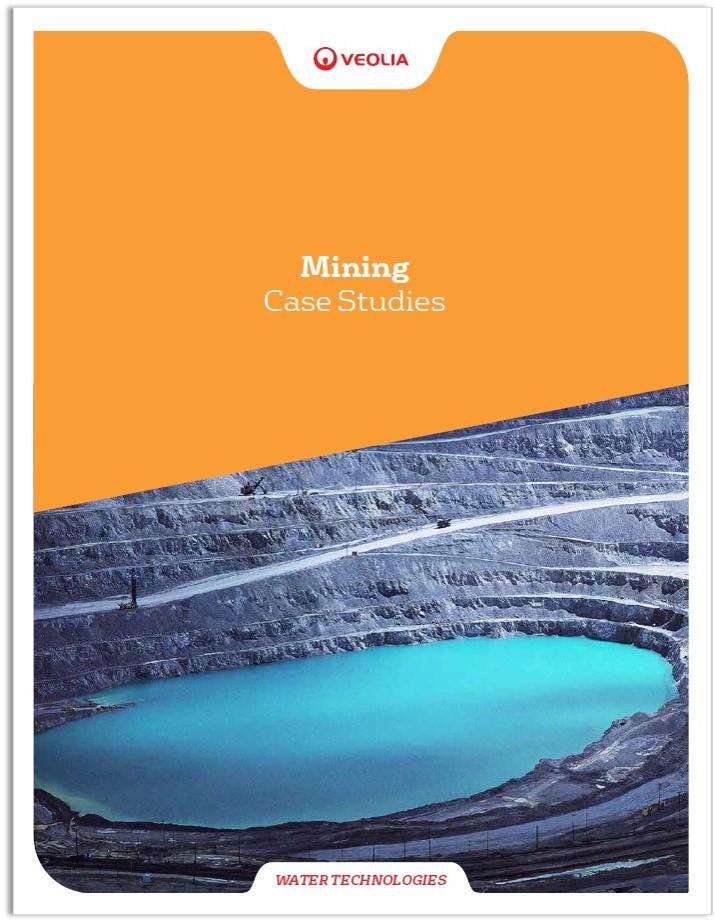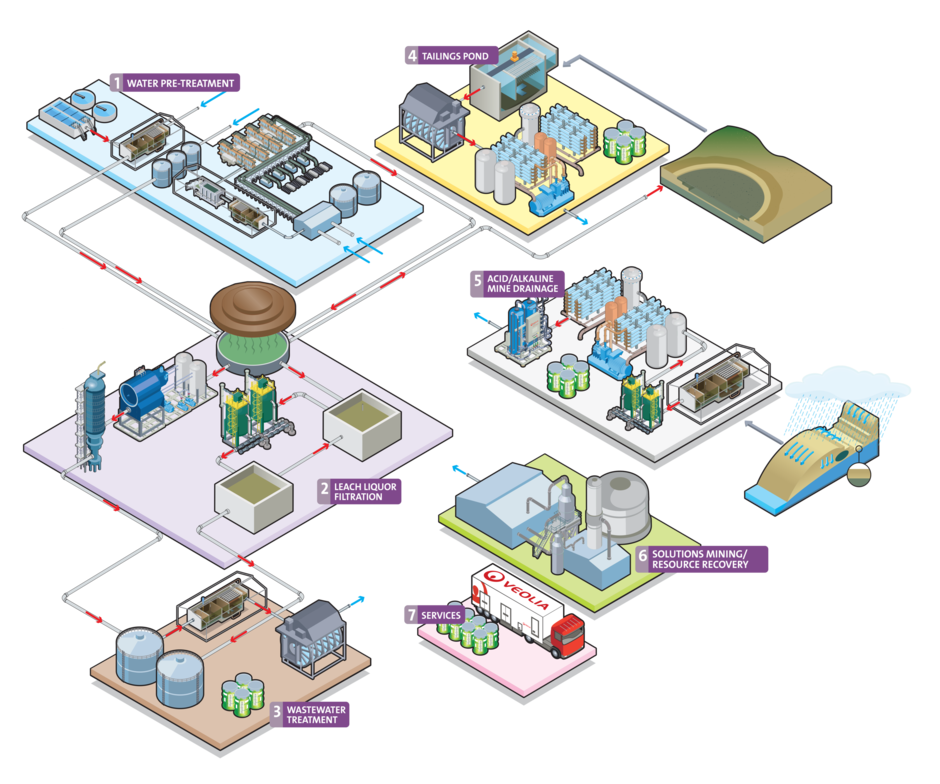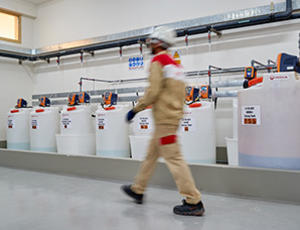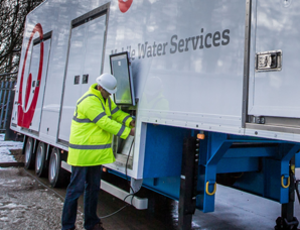Veolia Water Technologies partners with exploration, engineering, and mining companies to solve their mine water challenges, from production of potable water or desalinated water in remote locations to process water and mining wastewater treatment solutions for all types of hard and soft rock mining sites including solution mining.
We provide a full range of mining water treatment and filtration services including preliminary and detailed engineering, standard and custom water treatment equipment, project management, and maintenance support as well as long-term operation.
Meeting Your Needs:
- To improve productivity through mining water treatment technologies for production process requirements
- To manage environmental risks by treating contaminated water to achieve water quality suitable for reuse or for safe discharge into the environment
- To add value to the bottom line by treating sludge streams to recover suspended and dissolved constituents
- To have robust and reliable equipment requiring minimal unplanned maintenance
- To cope with production peaks while complying with stringent regulations
- To guarantee long-term efficiency and cost control through operations services
- To ensure your social license to operate

See how Veolia Water Technologies are supporting mining clients with a wide range of technology, project, and service offerings.
Click Here to Download
Applications
- Biological Wastewater
- Clarification/Softening
- Evaporation & Crystallization
- Filtration
- Ion Exchange
- Membrane Systems
- Metals Removal
- Precoat Filtration
- Process Water
- Remediation
- Reuse & Reclaim
- Sludge/Biosolids
- Utility Water Treatments
- Industrial Wastewater Treatment
- Water Treatment Chemicals
- ZLD Solutions
Services
Pre-Treatment

Regardless of the source of the intake water, Veolia's mine water treatment technologies ensure there is a consistent supply of water to the facility.
Leach Liquor Filtration
Veolia’s precoat filtration and vacuum deaeration technologies help gold and silver producers achieve maximum efficiency in their gold and silver recovery operations. By filtering the cyanide leach solution before zinc precipitation, precipitated impurities that could be carried over from the decantation steps are removed. No more than a trace of oxygen is left, minimizing zinc and cyanide consumption.
Wastewater Treatment
Veolia is experienced in helping clients reduce their financial exposure and comply with discharge requirements and stringent environmental regulations regarding water management. We understand the unique requirements of mining operations and our worldwide expertise in mine water issues allows us to offer specialized water treatment solutions that treat water and efficiently remove a wide range of contaminants such as heavy metals and minerals, arsenic, suspended solids, organics, iron, manganese, and specific ions that can impact the local environment.
Tailings Pond
Veolia offers a unique combination of water and solid waste treatment capabilities, which enable us to tailor solutions to each mine’s tailings challenge. Veolia ensures overflow compliance and water treatment, but we also look at the overall wastewater strategy. In particular, Veolia investigates opportunities to treat wastewater at source point to reduce the load going to tailings and we see tailings as an opportunity for water and metals recovery to make the most from the available resources.
Acid Mine Drainage
Operating mines, as well as abandoned mine sites, generates acid mine drainage which requires water treatment to prevent adverse impacts to rivers and streams. Veolia has developed a proprietary process known as DenseSludge™ to reduce sludge management costs and improve the operating efficiency of treatment plants. The process utilizes conventional equipment combined with our process expertise in sludge recycle techniques to form a heavier, denser sludge. This solution reduces sludge volume in the clarifier by up to 90% and improves lime utilization, resulting in significant savings.
Solutions Mining and/or Resource Recovery
Veolia provides the expertise required for several mining production processes. HPD® evaporation and crystallization systems are often a critical component in evaporites and solution mining, by-product recovery, and internal water process management for the mining industry.
Services
Veolia Water Technologies offers a wide range of mining water treatment service options for mines including Hubgrade™ digital services to monitor your mine water from a distance and mobile water and wastewater processing treatment solutions to cover emergency, temporary or long-term water treatment needs.

Focusing on system performance, compliance with process and environmental requirements and long-term cost-effectiveness, we are able to meet the most demanding standards of reliability, safety and quality.
- Tailings pond water treatment for reuse or discharge
- Gold / Silver cyanide solution treatment
- Merrill-Crowe clarification filters
- Treatment of contaminated pit and underground mine water
- Reuse of mine water for irrigation
- Heavy metals removal / metal recovery
- Ammonia / Nitrate removal
- Effluent treatment
- Sulfate reduction
- Potable water and sanitary systems (mining camps)
- Resource recovery
Veolia Water Technologies has proven expertise within a variety of different mine types including:
- Gold
- Silver
- Copper
- Iron
- Nickel
- Palladium
- Uranium
- Molybdenum
- Lithium
- Cobalt
- Coal
- Potash
Case Study - Canadian Gold Mine

Technology: Actiflo® and Hydrotech™ Discfilter
Location: British Columbia, Canada
A leading gold mine producer needed a wastewater treatment plant to remove Total Suspended Solids (TSS) and some heavy metals from their new gold mine effluent by using as little land space as possible while producing a solid waste. The permanent effluent treatment system consisted of several Veolia proprietary technologies which were selected for their robustness and compactness, starting with the Actiflo® high-rate ballasted clarification process for primary metals removal. The water was further polished by a highly-efficient Hydrotech™ Discfilter, which gave added insurance in meeting very stringent discharge criteria. A centrifuge was installed to dewater the sludge. The inlet flow was between 3,200 and 6,000 m3/d.
Veolia's innovative technologies for the mining industry include:

Actiflo® High-Rate Clarifier/Softener
Small-footprint technology in which water is flocculated with microsand and polymer to increase settling velocity for the removal of more than 99% of TSS.
Learn More

AnoxKaldnes™ MBBR (Moving Bed Biofilm Reactor)
Compact Moving Bed Biofilm Reactor engineered to effectively remove BOD/ COD and nitrogen, with a high tolerance to load variation and toxicity
Learn More

Hydrotech™ Discfilters
Mining filtration technology that uses woven media panels to remove suspended solids > than 10 microns.
Learn More

HPD® Evaporation & Crystallization
Evaporation and crystallization technologies to recover valuable products and byproducts. Brine concentration and product precipitation. Crystallizers for product purification.
Learn More

Multiflo® High-Rate Softener
Proprietary softening process that incorporates chemical precipitation with sludge thickening to produce an effluent with low concentrations of scale-formers and a highly concentrated sludge that can be easily dewatered.
Learn More

DenseSludge
High density sludge process that reduces the volume of sludge that needs to be disposed by as much as 90% compared with conventional processes.
Learn More

Hydrex Chemicals
Wide range of proprietary mining water treatment chemicals for use in all process, utility and wastewater applications
Learn More
Featured Resources
Webinars Available On-Demand
- Solving Complex Mine Water Issues with Mobile Water Treatment Solutions
- Removing Selenium from Industrial Wastewater
- Ensuring Environmental Compliance: Low Level Metals Removal from Mine Wastewater
- Reducing Toxicity from a Gold Mine Effluent
- Sulfate Removal From Mine Water
- Metals Removal Technologies for Mine Water
- Aquavista: Smarter Water Management for Mines
- Precoat Filtration 101
- The Remediation Water Treatment "Box of Tools" - Processes and Technologies Explained with Case Studies for Contamination with Heavy Metals, PFAS, Hydrocarbons, ARD/AMD, etc.
Case Studies
Mining Articles and Publications
- Mine Water Management Best Practices
- Moving Mining with Mobile Water Treatment
- Water Treatment for Abandoned Mine Sites
- A New Use for MBBR Technology
- Wastewater treatment using MBBR in cold climates
- How smart lithium miners choose evaporation and crystallization technologies to reduce risk and boost production
- Preparing for Tighter Mine Regulations
- Helping Mining Companies Meet Challenges of Water Scarcity and Stricter Regulations
- Removal of Selenium by Reduction to Selenite and Surface Complexation
Meet Our Team

Dave Oliphant
VP of Business Development - Heavy Industry
Canada & US

Albert Low
VP of Sales, Whittier Filtration
Los Angeles, CA

Chris Sakorafos
Sales Director, HPD® Evaporation and Crystallization
Chicago, IL

Jamie Hawes
Business Development Manager - Heavy Industry
Eastern Canada
More services for our mining clients
Frequently Asked Questions
What are the key elements of a mine's water management program?
There are three main elements of a mine water management program: water quantity, water quality and closure plans.
Water quantity
The quantity of water available at a mine site varies depending on the region. For example, in the western United States, water scarcity can play a role where the mine is reusing its pit water, but in parts of Canada, we are seeing the opposite where some mines have a positive water balance and have too much. Another thing to keep in mind is how climate change is going to impact the site’s water balance. This must be taken into account when determining the program. And finally, it is important to find the right balance between treatment capacity and storage needs: increased active treatment capacity reduces storage capacity and vice versa.
Water quality
What is the quality of the source water and how does the waste rock and tailings management impact the water quality? This along with the environmental regulations for effluent discharge are key in selecting the right technology for water treatment. It’s important to anticipate potential future regulations. For example, in British Columbia, Canada, regulations for selenium are becoming more and more stringent; mining companies are anticipating future regulations that may come into play in the near future, so they are already planning for these tighter regulations when developing their mine water treatment programs.
Closure plans
An often forgotten area when developing a mine water management program is to also keep in mind its closure plan. What is needed on a day-to-day basis for operations during the actual life of the mine is different from the actual post-closure operations.
What is acid rock / mine drainage?
Acid Rock Drainage (ARD) is a naturally occurring process that generates acidic (low pH) and metal-bearing solutions from reactions of certain minerals in rock material in the presence of oxygen (i.e. air) and water. While ARD is a natural process, its occurrence may be intensified by human activities such as road construction which disturb the rock. It is a common problem at mine sites that have sulfide material in the ore and waste streams (e.g. copper, lead/zinc and nickel sulfide operations, some gold operations, and some coal operations). Acidic solutions generated by ARD dissolve metals from the wastes, including copper, lead, zinc, arsenic, cadmium and iron. Such metals can be extremely toxic to fish and other aquatic life downstream and must be treated.
How do you treat acid mine drainage?
Operating mines, as well as abandoned mine sites, generate acid mine drainage which requires water treatment to prevent adverse impacts to rivers and streams. Veolia has developed a proprietary process known as DenseSludge™ to reduce sludge management costs and improve the operating efficiency of treatment plants that have acid mine drainage.
The DenseSludge™ recycle process forms particles that settle quickly, dewater readily, and hold little water. The result is a reduction in sludge generation by nearly 90% and production of a drier sludge, which reduces the volume of water that returns to the mine pool for re-treatment. The technology has enabled mining companies to extend the life of existing sludge storage facilities and reduce requirements for the building of new storage.
Why is a water treatment strategy vital for abandoned mines?
The process of dealing with — or remediating — a closed mine site can come with several key issues and challenges, especially from a water treatment perspective. At the end of their productive working lives, it is vitally important to ensure that mines are managed in a manner that mitigates or eliminates any potentially adverse effects. In practice, this means that the owners of individual abandoned or closed mine sites often have a duty of care to protect the natural environment — both in and around the area. They need to make every effort to eliminate the possibility of any negative impacts, which can include contamination of the surrounding land and surface watercourses, as well as the pollution of local groundwater supplies and drinking water aquifers.
In doing so, the deployment of an effective water treatment strategy is likely to form a key component for effective mine closure and reclamation. Contaminated water at closed mine sites can contain a range of harmful and toxic substances and dangerous chemicals, as well as metals such as cadmium, nickel, iron, copper and zinc. Such materials will tend to vary depending on the nature and location of the mine site. Furthermore, water at abandoned mine sites can be highly acidic, which can pose a dangerous threat to human, animal and plant life.
What is mining wastewater?
Various processes throughout the mining value chain – ore extraction, mineral processing and refining operations – generate substantial quantities of wastewater, some of it in the form of concentrated and highly polluted streams. Stringent regulations require these different types of wastewater to be treated before discharge to the environment. The treatment complexity of these wastewaters varies widely depending on their origin and the nature and quantity of contaminants they contain, either from the original ore, the mine environment, or the treatment processes employed.
Some highly toxic contaminants, such as cyanide, selenium, arsenic, cadmium, mercury and radioactive elements, may be found in wastewater from certain mining operations. Water from some hydrometallurgical processes such as leaching may be particularly heavily contaminated and need intensive treatment to filter the solution. In some cases such as gold cyanidation, appropriate filtration can clean the solution sufficiently to permit in-process reuse and minimize the impact on the WWTP. Pollution abatement processes to control gas or fume emissions in pyrometallurgy also result in water containing high concentrations of contaminants. However, it should be noted that some contaminated streams may contain substances that have economic value when recovered as by-products during treatment.
Some wastewater streams may be treated at source point for direct reuse onsite in another process, while others have to be routed to the wastewater treatment plant or to tailings ponds. In many cases, the largest volumes of wastewater end up in tailings ponds







